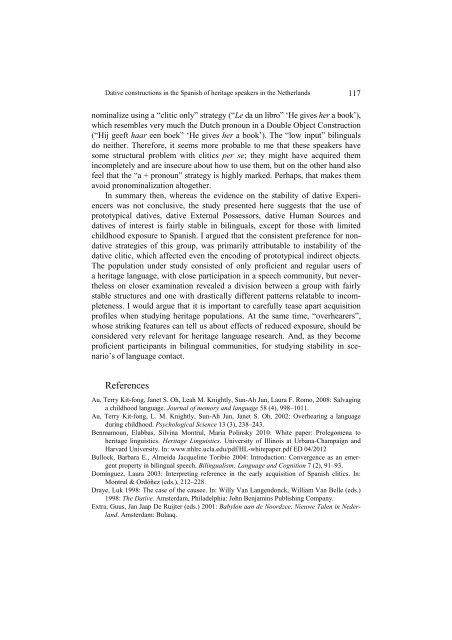s - Wyższa SzkoÅa Filologiczna we WrocÅawiu
s - Wyższa SzkoÅa Filologiczna we WrocÅawiu
s - Wyższa SzkoÅa Filologiczna we WrocÅawiu
You also want an ePaper? Increase the reach of your titles
YUMPU automatically turns print PDFs into web optimized ePapers that Google loves.
Dative constructions in the Spanish of heritage speakers in the Netherlands 117<br />
nominalize using a “clitic only” strategy (“Le da un libro” ‘He gives her a book’),<br />
which resembles very much the Dutch pronoun in a Double Object Construction<br />
(“Hij geeft haar een boek” ‘He gives her a book’). The “low input” bilinguals<br />
do neither. Therefore, it seems more probable to me that these speakers have<br />
some structural problem with clitics per se; they might have acquired them<br />
incompletely and are insecure about how to use them, but on the other hand also<br />
feel that the “a + pronoun” strategy is highly marked. Perhaps, that makes them<br />
avoid pronominalization altogether.<br />
In summary then, whereas the evidence on the stability of dative Experiencers<br />
was not conclusive, the study presented here suggests that the use of<br />
prototypical datives, dative External Possessors, dative Human Sources and<br />
datives of interest is fairly stable in bilinguals, except for those with limited<br />
childhood exposure to Spanish. I argued that the consistent preference for nondative<br />
strategies of this group, was primarily attributable to instability of the<br />
dative clitic, which affected even the encoding of prototypical indirect objects.<br />
The population under study consisted of only proficient and regular users of<br />
a heritage language, with close participation in a speech community, but nevertheless<br />
on closer examination revealed a division bet<strong>we</strong>en a group with fairly<br />
stable structures and one with drastically different patterns relatable to incompleteness.<br />
I would argue that it is important to carefully tease apart acquisition<br />
profiles when studying heritage populations. At the same time, “overhearers”,<br />
whose striking features can tell us about effects of reduced exposure, should be<br />
considered very relevant for heritage language research. And, as they become<br />
proficient participants in bilingual communities, for studying stability in scenario’s<br />
of language contact.<br />
References<br />
Au, Terry Kit-fong, Janet S. Oh, Leah M. Knightly, Sun-Ah Jun, Laura F. Romo, 2008: Salvaging<br />
a childhood language. Journal of memory and language 58 (4), 998–1011.<br />
Au, Terry Kit-fong, L. M. Knightly, Sun-Ah Jun, Janet S. Oh, 2002: Overhearing a language<br />
during childhood. Psychological Science 13 (3), 238–243.<br />
Benmamoun, Elabbas, Silvina Montrul, Maria Polinsky 2010: White paper: Prolegomena to<br />
heritage linguistics. Heritage Linguistics. University of Illinois at Urbana-Champaign and<br />
Harvard University. In: www.nhlrc.ucla.edu/pdf/HL-whitepaper.pdf ED 04/2012<br />
Bullock, Barbara E., Almeida Jacqueline Toribio 2004: Introduction: Convergence as an emergent<br />
property in bilingual speech. Bilingualism: Language and Cognition 7 (2), 91–93.<br />
Domínguez, Laura 2003: Interpreting reference in the early acquisition of Spanish clitics. In:<br />
Montrul & Ordóñez (eds.), 212–228.<br />
Draye, Luk 1998: The case of the causee. In: Willy Van Langendonck, William Van Belle (eds.)<br />
1998: The Dative. Amsterdam, Philadelphia: John Benjamins Publishing Company.<br />
Extra, Guus, Jan Jaap De Ruijter (eds.) 2001: Babylon aan de Noordzee. Nieu<strong>we</strong> Talen in Nederland.<br />
Amsterdam: Bulaaq.
















